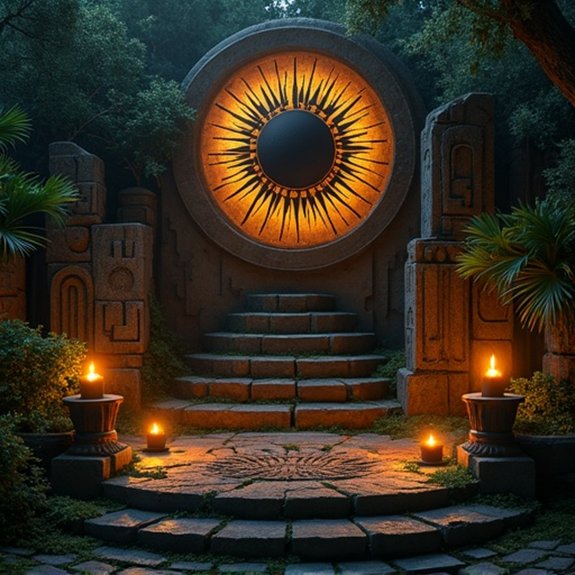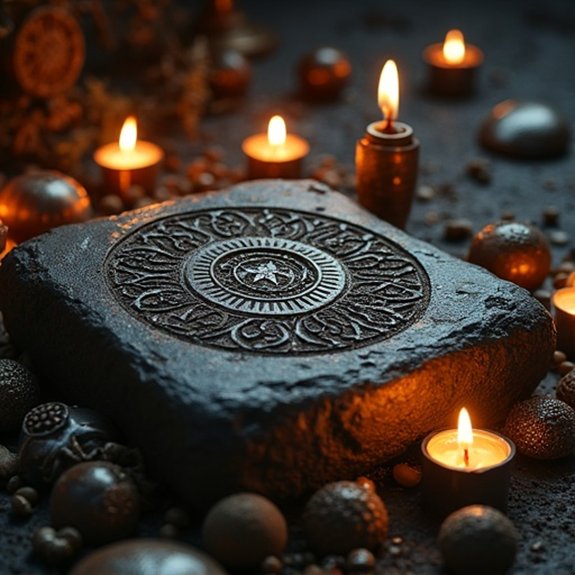The Black Sun: Occult Symbolism
The Black Sun‘s twelve spokes haven’t always meant what they do today. Throughout centuries, mystics and scholars have traced its origins from Mesopotamian temples to medieval grimoires, yet they can’t agree on its true purpose. Some claim it’s a portal to forbidden knowledge. Others insist it’s been misunderstood entirely. What they’ve discovered about this enigmatic symbol challenges everything conventional history teaches about ancient spiritual practices.
Introduction

When ancient civilizations first carved symbols into stone and painted them on temple walls, they weren’t just creating art—they were encoding hidden knowledge meant only for the initiated. Among these esoteric emblems, the Black Sun stands as one of history’s most controversial and misunderstood symbols. It’s appeared across cultures, from Bronze Age artifacts to medieval alchemical texts, each iteration carrying distinct meanings.
The symbol typically features twelve radial sig runes or spokes emanating from a central disc, creating a wheel-like design. While it’s gained notoriety through its appropriation by extremist groups, the Black Sun’s origins predate these associations by millennia. Understanding its true historical context requires examining archaeological evidence, mythological traditions, and occult philosophies that’ve shaped its evolution through time.
Ancient Mesopotamian Solar Deity Connections
Although modern interpretations of the Black Sun often overlook its ancient roots, Mesopotamian civilizations developed sophisticated solar symbolism that shares striking parallels with this enigmatic emblem. The Babylonian god Shamash represented both the sun’s life-giving power and its darker aspects during eclipses and winter solstices. His eight-pointed star symbol mirrors the Black Sun’s radiating design.
Akkadian texts describe “the dark sun” during cosmic battles between order and chaos. They believed solar deities traveled through the underworld nightly, becoming temporarily darkened yet retaining divine power. This duality appears in cylinder seals depicting inverted or blackened solar discs. Sumerian mythology’s Utu similarly embodied this paradox—simultaneously judge of the living and guide through death’s domain. These ancient concepts established foundational imagery that’d resurface in later esoteric traditions.
Notable Cases or Sightings

Since the mid-20th century, researchers have documented numerous encounters with the Black Sun symbol appearing in unexpected archaeological and historical contexts. In 1953, Heinrich Müller discovered a twelve-spoked wheel carved into a Mesopotamian tablet at Iraq’s National Museum, predating known European versions by millennia. Austria’s Wewelsburg Castle floor mosaic, installed during the 1930s, remains the most photographed example, attracting thousands of visitors annually.
Archaeological teams’ve uncovered similar designs in Tibet’s ancient monasteries and Peru’s pre-Columbian ruins. Digital archives now catalog over 400 verified instances across six continents. Most recently, drone surveys in 2019 revealed massive geoglyphs featuring the symbol in Kazakhstan’s Turgay region. These findings challenge previous assumptions about the symbol’s geographic origins and cultural transmission patterns.
Common Theories or Explanations
These widespread discoveries have sparked competing interpretations about the Black Sun‘s meaning and purpose. Esoteric researchers claim it’s an ancient symbol representing hidden spiritual knowledge, linking it to alchemical processes of transformation and enlightenment. They’ve traced connections to various mystical traditions, suggesting it embodies cosmic cycles of death and rebirth.
Historians argue it’s primarily a solar wheel symbol adopted by different cultures independently. They’ve documented its evolution from Bronze Age artifacts to medieval manuscripts, emphasizing its astronomical rather than occult significance.
Modern occultists interpret it as a portal to higher consciousness, while skeptics dismiss these theories as retrofitted meanings. Some scholars propose it’s simply decorative art misinterpreted through contemporary lens. The symbol’s ambiguity continues fueling debates across academic and esoteric circles.
Frequently Asked Questions
What Is the Difference Between the Black Sun and Traditional Sun Symbolism?
Traditional sun symbolism represents life, enlightenment, and divine light, while the Black Sun embodies hidden knowledge, transformation through darkness, and occult power. It’s associated with esoteric traditions, representing spiritual illumination achieved through shadow work.
How Do Modern Occult Practitioners Use Black Sun Imagery in Rituals?
Modern occult practitioners incorporate black sun imagery as meditation focal points, altar decorations, and visualization aids. They’ll often use it in shadow work rituals, transformation ceremonies, and practices exploring hidden knowledge or inner alchemy.
Are There Any Dangers Associated With Meditating on Black Sun Symbols?
Yes, practitioners warn that meditating on black sun symbols can trigger psychological distress, unwanted spiritual attachments, or energy imbalances. They’re also concerned about accidentally connecting with harmful entities or experiencing overwhelming shadow material that hasn’t been properly integrated.
Which Books Provide Accurate Information About Black Sun Occultism?
Nicholas Goodrick-Clarke’s “Black Sun: Aryan Cults, Esoteric Nazism and the Politics of Identity” offers scholarly analysis. Peter Levenda’s “Unholy Alliance” examines historical connections. Academic sources provide more reliable information than popular occult texts promoting practices.
What Materials or Colors Are Traditionally Used When Creating Black Sun Talismans?
Traditional practitioners typically craft black sun talismans using obsidian, black tourmaline, or darkened metals like blackened silver. They’ll incorporate deep purples, midnight blues, and gold accents alongside the predominant black to represent hidden solar energies.


